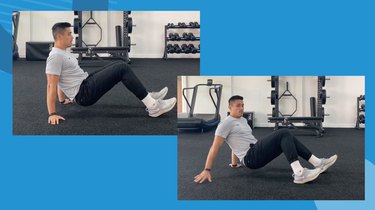

You may be familiar with inchworms or bear crawls, but it's time to add another animal-inspired move to your exercise routine: the crab walk.
- What is the crab walk? It's a total-body exercise that involves moving on your hands and feet while facing up.
- What is the crab walk exercise good for? It's pretty versatile. You can use it as a pre-workout warm-up, strength or cardio move. It builds strength, mobility and joint stability.
- What muscles does the crab walk work? It works your entire body, focusing on your shoulders, core and glute muscles.
- Who can do the drill? People who are free of shoulder injury and can comfortably down onto and back up off of the floor can safely try it.
Video of the Day
Ready to make like a crab during your next workout? Here's all you need to know about this all-over exercise.
How to Do the Crab Walk Exercise With Perfect Form
Watch the Full Crab Walk Tutorial
Crab Walk Instruction
- Start with your butt, hands and heels on the floor. Place your hands behind your back, flat on the floor. Brace your core.
- Press through your hands and heels and squeeze you glutes to raise your hips several inches off of the floor.
- On your hands and feet, walk backward by alternating steps with each hand and the opposite foot.
- After a few steps, change directions and walk forward back to start.
Tip
You can do these for reps or time. Start with 20 seconds and work up to longer intervals as you feel comfortable.
3 Crab Walk Exercise Benefits
1. Improved Shoulder Stability
Crab walks are a great tool for building shoulder strength and stability, according to California-based physical therapist Jereme Schumacher, DPT. Improving your stability can help decrease your risk of injury.
2. A Stronger Core
This drill also targets the core to improve balance and reducing your risk of lower back injury, according to a March 2019 study in PLOS One.
Improving your core strength can also help improve your posture while you're sitting or completing day-to-day activities, according to the Cleveland Clinic.
3. Warmed-Up Muscles
The crab walk is an excellent dynamic warm-up exercise. By warming up (aka activating) your muscles before your workouts, they're better able to fire, work and grow. For a great glute warm-up, try the banded progression below.
3 Crab Walk Mistakes
1. Keeping Your Elbows Bent
Throughout the movement, you want to keep your arms as straight as possible, Schumacher says. Stepping forward and back with bent elbows will put your shoulder in a compromising, potentially painful position because they're unable to stabilize your body.
2. Placing Your Whole Foot Down
Although it may feel more stable to keep your entire foot on the floor, this mistake actually takes away from some of the move's benefits.
"When performing a crab walk, you want to keep the front of your foot in the air, with a majority of your weight in your heels," Schumacher says. "This will ensure proper glute activation and hip stability throughout the exercise."
3. Taking Too Big of Steps
If you remember doing this move in elementary school, it was likely as part of a race. And while this may fly in gym class, it isn't the name of the game.
Instead, focus on taking smaller, more controlled steps with your hands and feet, Schumacher says. This will give you more ability to keep your body stable and injury-free throughout the exercise.
4. Leaning on Your Wrists
Putting too much weight on your hands can cause your wrists to feel sore or even painful. Keep your weight evenly balanced between your hands and feet. And if you start to feel pain, stop and stretch your wrists.
Make It Easier With This Crab Walk Modification
Although this on-the-floor exercise may not look super intense, that doesn't mean it's necessarily easy. Here's how to work up to the full move.
Lower Your Hips
With this exercise, the higher you hold your hips, the more difficult the movement feels, according to Schumacher. So, keeping your bottom relatively low to the floor will make the crab walk easier. Still keep your core tight and elbows straight.
3 Crab Walk Drill Progressions
1. Try the Banded Crab Walk
Adding a resistance band right above your knees is a great way to make this exercise a little more challenging, especially on your glutes.
Before you start this glute crab walk variation, add tension to the band by pushing the knees out. Raise the hips up and maintain tension on the band while you take steps forward and backward.
"This will significantly increase the demands on your hip stabilizer muscles," Schumacher says.
2. Raise Your Hips Higher
As mentioned above, how high you hold your hips changes up the exercise's difficulty. Raising your hips higher (while maintaining straight elbows and a braced midsection) will add a challenge to your glutes and core.
3. Change Directions
You can always do the exercise moving forward in back. But adding in some side-to-side walks challenges your hips and shoulders in a new plane of motion, for well-rounded strength benefits.
Related Reading
Was this article helpful?
150 Characters Max
0/150
Thank you for sharing!
Thank you for your feedback!